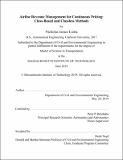Airline revenue management for continuous pricing : class-based and classless methods
Author(s)
Liotta, Nicholas James.
Download1128269448-MIT.pdf (3.001Mb)
Other Contributors
Massachusetts Institute of Technology. Department of Civil and Environmental Engineering.
Advisor
Peter P. Belobaba.
Terms of use
Metadata
Show full item recordAbstract
The development of the New Distribution Capability for airlines has raised interest within the airline industry in "continuous pricing", where fares offered to customers are not limited to a set of pre-determined price points. This thesis provides an overview of experiments on four revenue management (RM) methods proposed for the practical implementation of continuous pricing. Two of these methods, termed class-based RM for continuous pricing, utilize existing forecasting and seat protection optimization methods to determine what fares to offer. The other two methods, termed classless RM, calculate optimal fares based on the maximization of expected revenue contribution at a given point in time during the booking process. This thesis examines the performance of probabilistic bidprice and unbucketed dynamic programming methods for both the class-based and the classless methods for continuous pricing. The continuous pricing methods are compared with traditional class-based methods in unrestricted fare structures using the Passenger Origin Destination Simulator. Compared to a baseline with six fare classes, when two competing airlines both implement class-based continuous pricing, revenues can increase by up to 1%, and, when both airlines implement classless pricing, they can gain up to 2% in revenue. When only one airline implements continuous pricing in a competitive setting, revenue gains of 10-13% are possible over the six-fare class baseline. These larger gains mostly come at the expense of the competitor, which loses revenue and bookings. For all cases, as the number of fare classes in the baseline increases, the revenue gains of continuous pricing are diminished and may even become revenue losses under certain conditions. The positive results of the continuous pricing methods are a result of the increased price granularity offered by continuous pricing. It is this price granularity that causes most of the revenue gains when a competitor airline does not switch to continuous pricing. The price granularity effect also explains why increasing the number of fare classes with the traditional class-based RM methods can generate as much and sometimes more revenue than the continuous pricing methods.
Description
This electronic version was submitted by the student author. The certified thesis is available in the Institute Archives and Special Collections. Thesis: S.M. in Transportation, Massachusetts Institute of Technology, Department of Civil and Environmental Engineering, 2019 Cataloged from student-submitted PDF version of thesis. Includes bibliographical references (pages 131-132).
Date issued
2019Department
Massachusetts Institute of Technology. Department of Civil and Environmental EngineeringPublisher
Massachusetts Institute of Technology
Keywords
Civil and Environmental Engineering.